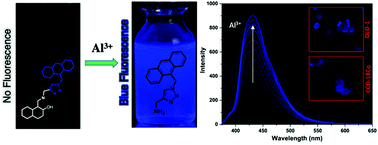Synthesis and cell imaging studies of an unusual “OFF–ON” fluorescent sensor containing a triazole unit for Al3+ detection via selective imine hydrolysis†
Abstract
Monitoring excess Al3+ in biological and environmental samples is a major goal for scientists due to its harmful effects. Thus, the development of selective and convenient techniques for Al3+ recognition is essential. Herein, we present the design of a new fluorescent molecule, A1, for the recognition of Al3+. The results indicated that the recognition mechanism of the imine hydrolysis of A1 for Al3+ was completely different from those of other Al3+ probes that function based on chelation-enhanced fluorescence. A1 demonstrated a highly selective fluorescence response in the “OFF–ON” mode toward the presence of Al3+ among a pool of analytes including 18 cations with striking blue emission. Moreover, it has a prominent LOD value (0.117 μM), fast response time (10 s) and increasing linear emission relationship with Al3+ concentration (0–20.0 μM). Bioimaging studies in human colorectal carcinoma cells (DLD-1) and healthy epithelial cells (CCD-18Co) demonstrated excellent results. The performance of A1 toward Al3+ proved that it can be exploited as a signal tool for environmental and biological samples.



 Please wait while we load your content...
Please wait while we load your content...